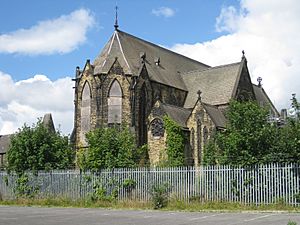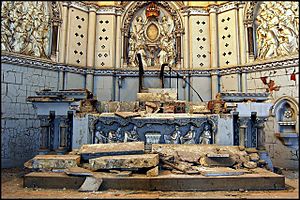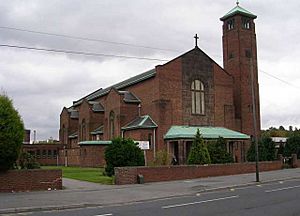Mount St Mary's Church, Leeds facts for kids
Quick facts for kids Mount St Mary's Church |
|
|---|---|
| Church of the Immaculate Virgin Mary | |

East side of the church
|
|
| Lua error in Module:Location_map at line 420: attempt to index field 'wikibase' (a nil value). | |
| OS grid reference | SE3130433169 |
| Location | Richmond Hill, Leeds |
| Country | England |
| Denomination | Roman Catholic |
| History | |
| Status | Closed |
| Founded | 1851 |
| Founder(s) | Missionary Oblates of Mary Immaculate |
| Dedication | Blessed Virgin Mary |
| Dedicated | 29 July 1857 |
| Architecture | |
| Functional status | Redundant church |
| Heritage designation | Grade II* listed |
| Designated | 5 August 1976 |
| Architect(s) | Joseph Hansom Edward Pugin |
| Style | Gothic Revival |
| Groundbreaking | 24 May 1853 |
| Completed | 13 September 1866 |
| Construction cost | £8,000 |
| Closed | June 1989 |
| Specifications | |
| Length | 165 ft (50 m) |
| Width | 100 ft (30 m) |
| Nave width | 60 ft (18 m) |
| Height | 85 ft (26 m) |
Mount St Mary's Church, also known as the Church of the Immaculate Virgin Mary, is a historic Roman Catholic church building in Leeds, West Yorkshire, England. It was built starting in 1851 and was designed by Joseph Hansom, with later parts added by Edward Pugin. The church is located next to Mount St Mary's Catholic High School, Leeds. It is a "Grade II* listed building," which means it's a very important historical building. Part of the church was taken down in 2024 to make space for new homes.
Contents
History of Mount St Mary's Church
Building the Church
In 1851, a group of priests called the Missionary Oblates of Mary Immaculate came to Leeds. They wanted to start a new church for the local Catholic community. Many people, especially Irish migrants, lived in the Richmond Hill area of Leeds and needed a church closer to them. The first priest, Father Crowe, helped raise money to buy the land. The church was also called the 'Famine Church'. This was because it was built as Irish people were recovering from the Great Irish Famine. It gave them hope after a very difficult time.
On May 24, 1853, the first stone of the church was laid by Bishop John Briggs. The main architect was Joseph Hansom. He also designed other famous churches like Plymouth Cathedral. These churches, including Mount St Mary's, were built in the Gothic Revival style, which looks like old medieval churches. In the same year, Mount Saint Mary's School opened next door. Nuns from the Sisters Oblates of Mary Immaculate taught there and used the church for their prayers.
The church was officially opened on July 29, 1857, by Bishop Briggs. Important church leaders attended, including Cardinal Nicholas Wiseman and Henry Manning, who later became cardinals. Also present was Eugène de Mazenod, the founder of the Oblates, who became a saint in 1995. They walked through the city streets before celebrating Mass in the church.
At first, only the main part of the church (the nave) and the side aisles were finished. The back part of the church (the chancel) and the side sections (transepts) were designed by Edward Pugin. He worked with Joseph Hansom for a short time. The entire church was finally completed and opened on September 13, 1866. Cardinal Manning led the ceremony.
In 1916, people started collecting money to build a tall tower for the church. This tower was part of the original design. However, because the First World War was happening, the tower was never built.
Church Repairs and Discoveries
Mount St Mary's Church is on a hill, so it often faced strong winds. It was damaged in December 1894 and February 1962 and needed repairs. The church was also renovated several times between the 1930s and 1950s, and again from 1980 to 1981.
In 1953, during some renovation work, an old coal mine was found under the church! There was a mine shaft that had been blocked off when the church was first built. The local council had no records of this mine, but it confirmed what many people in the area suspected. A study in 2007 found that there were actually several mines at different levels, dating from the late 1600s to 1877.
Changes in the Community
From 1935 to 1950, many people living near the church moved to new homes in the Osmondthorpe area of Leeds. This meant that the number of people attending Mount St Mary's Church dropped a lot. Before the Second World War, the church community went from 6,000 people to 3,000. After the war, it was only 1,100 people. Even though efforts were made to encourage people to return, by 1979, the community had shrunk to 790 people.
Modern Changes
In 1953, the orphanage that the nuns had run since 1853 closed. Over 3,000 children had lived there. In 1967, a new social centre was built for the church community.
After the Second Vatican Council, which was a big meeting of Catholic leaders, new ways of celebrating Mass were introduced. On October 18, 1964, the Mass started to be said in English instead of Latin. In July 1971, a new altar was added so the priest could face the people during Mass. In April 1978, a parish council was created to help run the church. In the same year, Mount St Mary's School became a comprehensive school.
On November 30, 1986, Mount St Mary's Church and the nearby Anglican church, St Saviour's, made an official agreement to work together. This was signed by the Roman Catholic Bishop of Leeds, David Konstant, and the Anglican Bishop of Ripon, David Young.
Church Design
Outside the Church
The church is a great example of Gothic Revival architecture from the 1800s. It has brick walls and a very steep, slanted roof. This is similar to other churches designed by Joseph Hansom, like St Walburge Church and Plymouth Cathedral.
The church has a tall main section (nave) and a rounded back part (chancel). It faces east and has two side sections (transepts) on the north and south. Each transept has a large round "rose window" above three smaller, tall windows.
Above the windows along the sides and at the back, there are pointed roof sections called gables. These gables have carved Greek crosses. The large window at the front (west window) has detailed stone patterns called tracery. Below it is an arched doorway. The windows also have special stone ledges called hood moulds to stop rainwater from hitting the walls below.
Inside the Church
Inside, there is one main aisle in the middle and two narrower aisles on either side. Tall columns support pointed Gothic arches along the main aisle. There are six columns from the back of the church to the chancel. From there, seven steps lead up to the sanctuary, which is the most sacred part of the church. This area has two more columns and three Gothic arches around it.
The altar is made of marble, but its top surface has been broken since the church closed. Around the altar, there are three sculptures carved into the wall. The middle sculpture shows angels. The one on the north side shows church leaders and saints. The one on the south side shows kings and queens. All of them are kneeling towards a symbol of the Blessed Sacrament, which is being crowned by angels.
In the north aisle, there are still small rooms called confessionals where people would go for confession. The floor in the main part of the church is made of wood, while the floor in the sanctuary is tiled. Some of the beautiful stained-glass windows are still in the church. They were made by Hardman & Co. and have protective screens on them.
Other Churches in the Parish
To serve the Catholic people who moved to Osmondthorpe, a new church called Corpus Christi Church was built. It was like a "daughter parish" of Mount St Mary's. The Oblate priests also served this new church. It was first a wooden building, but it burned down in the early 1950s. The current Corpus Christi Church was built in the 1960s and opened in 1962.
The Oblates continued to serve Corpus Christi Church until 2008. Then, they handed it over to the Roman Catholic Diocese of Leeds, which still manages the church today. In 2011, Corpus Christi Church joined with two other churches, St Theresa of the Child Jesus in Cross Gates and St Gregory the Great in Swarcliffe. Together, they became part of the Parish of Blessed John Henry Newman.
Closure of Mount St Mary's
As the number of people attending Mount St Mary's Church kept getting smaller, and the cost to keep the church in good repair grew, the Oblate priests decided they could no longer manage the parish. It was estimated that repairing the church would cost £1.5 million, which was too much for a church with so few people.
In June 1989, the Oblates of Mary Immaculate gave the church to the Diocese of Leeds. The church was then "deconsecrated," meaning it was no longer used as a church. Both groups hoped to sell the building so it could still be used by the local community in a different way. In 1996, it was sold to Sanctuary Housing Trust for a very small amount of money. Since then, the building has not been used. You can see scaffolding around the church, which means only basic repairs have been done to keep it safe.
The Victorian Society, a group that protects historic buildings, has named Mount St Mary's Church a heritage building that is at risk of falling apart.
Past Leaders of the Parish
The priests who were in charge of Mount St Mary's parish, from the Missionary Oblates of Mary Immaculate, included:
|
|
See also
- Mount St Mary's Catholic High School, Leeds
- Missionary Oblates of Mary Immaculate
- Diocese of Leeds
- Grade II* listed buildings in Leeds
- Listed buildings in Leeds (Burmantofts and Richmond Hill Ward)






